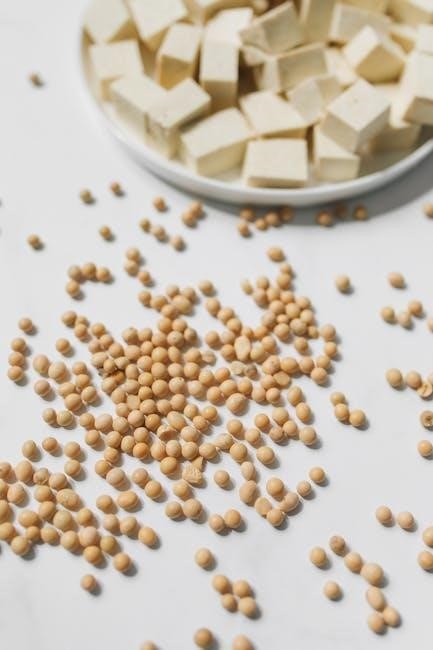Overview of Hill’s I/D Low Fat Dog Food
Hill’s Prescription Diet i/d Low Fat is a highly digestible, low-fat dog food formulated by veterinarians and nutritionists to support digestive health and well-being in dogs․
1․1 What is Hill’s Prescription Diet i/d Low Fat?
Hill’s Prescription Diet i/d Low Fat is a veterinarian-recommended, highly digestible dog food formulated to support digestive health in dogs with specific dietary needs․ It is designed for dogs requiring a low-fat diet to manage gastrointestinal disorders and fat-responsive conditions․ This clinical nutrition is crafted with easily digestible ingredients to reduce digestive upset and promote overall well-being․
As a dietetic pet food, it is specifically tailored to help settle digestive issues while maintaining optimal weight and health․ It is a complete and balanced formula that can be used long-term under veterinary guidance․
1․2 Key Features of the Formula
Hill’s Prescription Diet i/d Low Fat is formulated with highly digestible ingredients to minimize gastrointestinal upset․ It features a reduced fat content, making it ideal for dogs with fat-sensitive digestive issues․ The recipe is balanced to provide essential nutrients for overall health while supporting digestive well-being․ It is veterinary-recommended and designed to help manage conditions requiring a low-fat diet․ This formula is also suitable for dogs with sensitive stomachs and supports healthy digestion without compromising on taste or nutritional value․
1․3 Who is This Diet Suitable For?
Hill’s Prescription Diet i/d Low Fat is specifically designed for dogs with digestive issues that benefit from a low-fat diet․ It is ideal for dogs with conditions like pancreatitis, inflammatory bowel disease, or fat malabsorption․ Additionally, it suits dogs that experience gastrointestinal upset, such as diarrhea or vomiting, due to sensitive stomachs․ This formula is also appropriate for dogs needing a highly digestible diet to support recovery or manage food sensitivities․ Always consult a veterinarian to determine if this diet is suitable for your dog’s specific health needs․

Key Characteristics of Hill’s I/D Low Fat Formula
Hill’s I/D Low Fat Formula features highly digestible ingredients, reduced fat content, and balanced nutrients to support digestive health and overall well-being in dogs․
2․1 Highly Digestible Ingredients
Hill’s I/D Low Fat Formula is crafted with highly digestible ingredients to minimize stomach upset and promote nutrient absorption․ Chicken or egg products serve as easily digestible protein sources, reducing the risk of adverse reactions․ The formula avoids triggers like artificial flavors and preservatives, ensuring gentleness on sensitive digestive systems․ Additionally, the balanced blend of fiber sources aids in smooth digestion, preventing common issues like diarrhea or constipation․ These ingredients work synergistically to support dogs with gastrointestinal challenges, ensuring they receive the nutrients needed for recovery and overall health without compromising on palatability or nutritional value․
2․2 Low-Fat Content for Digestive Health
Hill’s I/D Low Fat Formula features a reduced fat content, specifically designed to support dogs with digestive sensitivities or fat-responsive conditions․ Lower fat levels help minimize strain on the digestive system, reducing the risk of inflammation or pancreatitis․ This formulation is particularly beneficial for dogs that have difficulty processing higher-fat foods․ By limiting fat intake, the diet helps regulate digestion and alleviate symptoms like diarrhea or vomiting․ The balanced approach ensures essential fatty acids are still present to support skin and coat health, making it a nutritious choice for dogs requiring a low-fat diet for optimal digestive well-being․
2․3 Balanced Nutrition for Optimal Health
Hill’s I/D Low Fat Formula is crafted to deliver balanced nutrition, ensuring dogs receive all essential nutrients for overall well-being․ The recipe combines high-quality protein sources, such as chicken or turkey, with easily digestible carbohydrates like rice and corn․ It also includes a tailored blend of vitamins and minerals to support immune function, energy levels, and skin health․ This balanced approach ensures dogs thrive even on a low-fat diet, making it a comprehensive choice for maintaining their long-term health without compromising on nutritional quality or palatability․

Benefits of Feeding Hill’s I/D Low Fat
- Supports improved digestion and reduces gastrointestinal upset․
- Helps manage fat-responsive conditions and promotes healthy weight․
- Provides balanced nutrients for overall wellness and vitality․
3․1 Supports Digestive Health
Hill’s I/D Low Fat is specifically formulated to support digestive health in dogs․ The recipe uses highly digestible ingredients like chicken and easy-to-absorb carbohydrates, reducing the risk of gastrointestinal upset․ By minimizing fat content, it lessens the strain on the digestive system, making it ideal for dogs with sensitive stomachs or those recovering from digestive issues․ The balanced blend of fiber and enzymes helps maintain a healthy gut, promoting regular bowel movements and overall digestive comfort․ This makes it a great option for pets needing a gentle, easily tolerated diet to restore and maintain their digestive well-being․
3․2 Helps Manage Fat-Responsive Disorders
Hill’s I/D Low Fat is designed to help manage fat-responsive disorders in dogs․ By significantly reducing fat content, it alleviates conditions like hyperlipidemia and pancreatitis․ The formula’s balanced nutrient profile ensures dogs receive essential vitamins and minerals without excessive fat․ This makes it ideal for pets requiring a low-fat diet to manage specific health issues․ Veterinarians often recommend this formula for dogs with fat-sensitive conditions, as it helps reduce symptoms like vomiting or diarrhea associated with fat intake․ It supports long-term management while maintaining overall nutritional balance for optimal health․
3․4 Promotes Healthy Weight Management
Hill’s I/D Low Fat supports healthy weight management by reducing fat content, which helps lower calorie intake․ This makes it an excellent option for dogs needing to shed pounds or maintain an ideal weight․ The balanced formula ensures dogs receive essential nutrients without excess fat, preventing obesity․ With controlled fat levels, it helps maintain muscle mass while promoting a leaner body condition․ This diet is particularly beneficial for dogs with weight-related health issues, helping them achieve and sustain a healthy weight for improved overall well-being and longevity․

Feeding Guidelines for Hill’s I/D Low Fat
Follow the feeding guidelines to ensure optimal nutrition․ Feed according to your dog’s weight, age, and health condition․ Consult your veterinarian for personalized recommendations to meet your dog’s specific needs․
4․1 General Feeding Instructions
Start by following the feeding guide on the product packaging, as portions are tailored to your dog’s weight and activity level․ Always consult your veterinarian to determine the ideal amount for your dog․ Divide the daily ration into 2-3 meals to prevent overeating and support digestion․ Ensure fresh water is always available․ Gradually transition your dog to Hill’s I/D Low Fat over 7-10 days to avoid digestive upset․ Stick to the recommended feeding schedule to maintain your dog’s health and prevent overfeeding, which can lead to weight gain and other issues․ Adjust portions based on your vet’s advice for best results․
4․2 Adjusting Feeding Amounts for Optimal Weight
Monitor your dog’s weight and adjust feeding amounts gradually to prevent digestive upset․ Factors like activity level, age, and metabolism influence portion sizes․ As a guideline, increase or decrease by 1/4 cup per 10 pounds of body weight․ Always consult your veterinarian for personalized advice, as they can assess your dog’s specific needs․ Regular check-ups ensure your dog maintains a healthy weight on Hill’s I/D Low Fat․ Adjustments should align with your vet’s recommendations to support overall health and digestion․
4․3 Transitioning to Hill’s I/D Low Fat
Transitioning your dog to Hill’s I/D Low Fat should be done gradually to prevent digestive upset․ Start by mixing a small amount (e․g․, 25%) with their current food and increase the proportion over 7-10 days․ This allows their digestive system to adapt smoothly․ Monitor your dog’s behavior, appetite, and stool quality during the transition․ If any adverse reactions occur, consult your veterinarian for guidance․ A slow transition ensures your dog adjusts comfortably to the new formula, minimizing the risk of gastrointestinal issues․
Importance of Low-Fat Diets for Dogs
Low-fat diets aid digestion, reduce fat-related issues, and support canine health․ Hill’s I/D is a veterinarian-recommended option for managing digestive needs effectively․
5․1 How Fat Affects Canine Digestion
Fat intake significantly impacts a dog’s digestive health․ High fat levels can slow digestion, overwhelming the system and leading to issues like diarrhea or pancreatitis․ Excessive fat may also cause malabsorption of nutrients, exacerbating digestive discomfort․ For dogs with sensitive stomachs or conditions like pancreatitis, a low-fat diet minimizes strain on the digestive tract, promoting healthier digestion and reducing inflammation․ Hill’s I/D Low Fat is formulated to balance fat content, ensuring optimal nutrient absorption while maintaining digestive comfort․ This makes it an ideal choice for dogs requiring gastrointestinal support․
5․2 Benefits of Low-Fat Diets for Digestive Issues
Low-fat diets are particularly beneficial for dogs experiencing digestive issues․ By reducing the fat content, these diets minimize the strain on the digestive system, which can help prevent flare-ups of conditions like pancreatitis․ Easier digestion leads to better nutrient absorption, supporting overall health․ Hill’s I/D Low Fat is specifically formulated to support digestive health, making it an ideal choice for dogs with gastrointestinal sensitivities․ The balanced approach ensures that dogs receive essential nutrients without the digestive discomfort associated with higher fat intake, thus aiding in the management of digestive disorders effectively․
5․3 Role of Fat in Canine Nutrition
Fat plays a crucial role in canine nutrition, serving as a primary energy source and aiding in the absorption of fat-soluble vitamins like A, D, E, and K․ It also supports skin and coat health, as well as brain function․ However, excessive fat intake can lead to weight gain and other health issues, such as pancreatitis․ Hill’s I/D Low Fat balances this by providing essential fatty acids while maintaining a reduced fat content, ensuring dogs receive the benefits of fat without the risks associated with overconsumption․ This balanced approach supports overall health and well-being in dogs with specific dietary needs․

Nutritional Profile of Hill’s I/D Low Fat
Hill’s I/D Low Fat features high-quality protein sources, high fiber, and easily digestible carbohydrates․ It contains approximately 5-10% fat on a dry matter basis, ensuring optimal digestion․ Essential vitamins and minerals are added for comprehensive nutrition․
6․1 Macronutrient Breakdown
Hill’s I/D Low Fat dog food provides a balanced macronutrient profile to support digestive health․ Protein content is approximately 20-25% on a dry matter basis, sourced from easily digestible ingredients like chicken or lamb․ Fat is limited to 5-10%, reducing the risk of fat-related digestive issues․ Carbohydrates make up the majority, around 50-60%, from sources like rice or barley, ensuring energy needs are met without overwhelming the digestive system․ Fiber content is moderate, around 3-5%, aiding in healthy digestion․ This macronutrient balance is designed to promote optimal nutrient absorption and overall well-being in dogs with sensitive stomachs․
6․2 Vitamin and Mineral Content
Hill’s I/D Low Fat is enriched with essential vitamins and minerals to support overall health․ Vitamin E acts as a powerful antioxidant, protecting cells from damage, while Vitamin C supports immune function․ Vitamin D is included for healthy bone development and calcium absorption․ Minerals like calcium and phosphorus promote strong bones and teeth, and potassium supports muscle function․ The formula also includes trace minerals such as zinc and iron for immune health and energy production․ Taurine is added to support heart health․ This balanced blend ensures your dog receives all necessary nutrients for optimal well-being․
6․3 Other Key Nutrients
Hill’s I/D Low Fat contains fiber from beet pulp to support healthy digestion and bowel function․ Omega-3 fatty acids from fish oil promote skin health and joint mobility․ Antioxidants like vitamin E help combat oxidative stress and protect cells․ The formula also includes amino acids, such as carnitine, to support energy metabolism and muscle health․ These nutrients work together to ensure your dog’s overall well-being, providing a comprehensive approach to managing digestive health while maintaining essential bodily functions․ Each ingredient is carefully balanced to meet your dog’s nutritional needs effectively․

Common Digestive Issues in Dogs
Dogs often face gastrointestinal disorders, including diarrhea, vomiting, and upset stomachs, frequently caused by food sensitivities or infections․ Fat-responsive conditions like pancreatitis also occur, necessitating dietary adjustments․
7․1 Gastrointestinal Disorders
Gastrointestinal disorders in dogs often manifest as diarrhea, vomiting, or stomach inflammation․ These issues can stem from infections, food sensitivities, or inflammation․ Conditions like gastroenteritis or inflammatory bowel disease are common․ Hill’s I/D Low Fat is formulated to support dogs with such digestive challenges, offering easily digestible ingredients to reduce strain on the gut․ By minimizing fat content, it helps alleviate symptoms and supports the recovery of dogs with sensitive stomachs or fat-responsive conditions, promoting a healthier digestive system․
7․2 Fat-Responsive Conditions
Fat-responsive conditions in dogs, such as pancreatitis or hyperlipidemia, often require dietary adjustments to manage symptoms․ These conditions are triggered by high fat intake, leading to inflammation or elevated blood lipid levels․ Hill’s I/D Low Fat is specifically designed to address these issues by limiting fat content while providing essential nutrients․ This formulation helps reduce the strain on the pancreas and supports normal lipid metabolism, making it an effective option for dogs needing a low-fat diet to manage fat-responsive health challenges․
7․3 Signs of Digestive Upset
Common signs of digestive upset in dogs include vomiting, diarrhea, lethargy, and loss of appetite․ These symptoms often indicate gastrointestinal distress, which can stem from food sensitivities, infections, or dietary indiscretion․ In some cases, dogs may exhibit abdominal pain or bloating․ Persistent digestive issues warrant veterinary attention to rule out underlying conditions․ Identifying these signs early can help pet owners address the problem promptly, potentially through dietary changes like transitioning to Hill’s I/D Low Fat, which is formulated to support digestive health and alleviate such symptoms․

Role of Veterinarians in Diet Recommendations
Veterinarians play a crucial role in recommending diets like Hill’s I/D Low Fat, ensuring it meets the dog’s specific health needs based on professional expertise and assessment․
8․1 Importance of Veterinary Consultation
Consulting a veterinarian is essential before transitioning your dog to Hill’s I/D Low Fat․ They assess your dog’s health, diagnose conditions, and recommend the most suitable diet․ Vets ensure the food addresses specific issues like digestive disorders or fat sensitivities․ Their expertise helps prevent nutrient deficiencies and optimizes your dog’s well-being․ Regular check-ups allow them to monitor progress and adjust feeding plans as needed․ A vet’s guidance ensures a smooth transition and maximizes the benefits of the low-fat formula for your dog’s long-term health․
8․2 How Vets Determine the Need for a Low-Fat Diet
Veterinarians determine the need for a low-fat diet by evaluating a dog’s medical history, symptoms, and specific health conditions․ They assess digestive issues, fat absorption problems, or weight-related concerns․ Diagnostic tests, such as blood work or stool analysis, may be conducted to confirm conditions like pancreatitis or gastrointestinal disorders․ The vet also considers the dog’s overall health and whether a low-fat diet aligns with their nutritional needs․ This comprehensive approach ensures the diet is tailored to address specific health challenges effectively․
8․3 Monitoring Progress with Hill’s I/D
Veterinarians closely monitor a dog’s progress on Hill’s I/D Low Fat by assessing improvements in digestive health and overall well-being․ They evaluate factors such as stool quality, reduction in digestive symptoms, and weight management․ Regular check-ups are scheduled to ensure the diet is meeting the dog’s nutritional needs and to address any potential side effects․ Adjustments to feeding amounts or transitions to maintenance diets may be recommended based on the dog’s response․ Consistent veterinary monitoring ensures the dog receives optimal benefits from the low-fat formula․

Storage and Handling Tips
Store Hill’s I/D Low Fat in a cool, dry place․ Keep in original packaging, use a clean scoop, and seal tightly to maintain freshness and prevent contamination․
9․1 Proper Storage of Hill’s I/D Low Fat
Store Hill’s I/D Low Fat in a cool, dry place away from direct sunlight․ Keep the food in its original packaging to preserve freshness and prevent exposure to moisture․ Use a clean, dry scoop to serve, and reseal the bag tightly after each use․ Avoid storing in humid or warm areas, as this can affect the quality and shelf life of the food․ Ensure the storage area is clean and free from pests to maintain hygiene․ Proper storage helps retain the nutritional value and ensures your dog gets the best out of their meals․
9․2 Maintaining Freshness
To maintain the freshness of Hill’s I/D Low Fat, always seal the bag tightly after each use․ Store it in an airtight container to protect against moisture and pests․ Keep the food in its original packaging to preserve flavor and nutrients․ Avoid exposing the food to direct sunlight or heat sources, as this can cause degradation․ Use the food within the recommended timeframe after opening, typically 30 days․ Regularly check the food for any signs of spoilage, such as an off smell or mold, before serving to your dog․ Freshness ensures optimal nutrition and palatability․
9․3 Expiration and Shelf Life
Hill’s I/D Low Fat Dog Food has a clearly marked expiration date on the packaging․ The shelf life is typically 12-18 months from the manufacturing date when stored properly․ Always check the expiration date before purchasing․ Once opened, the food should be consumed within 30 days for optimal freshness․ Store it in a cool, dry place to maintain its quality․ Never feed your dog expired food, as it may lose its nutritional value and safety․ Always follow the feeding guide and consult your veterinarian if you have concerns about shelf life or expiration․

Frequently Asked Questions
This section addresses common queries about Hill’s I/D Low Fat, such as feeding duration, visible improvements, and mixing with other foods, providing clarity for pet owners․
10․1 Can I Feed Hill’s I/D Long-Term?
Hill’s I/D Low Fat is formulated to support long-term feeding when recommended by a veterinarian․ It provides balanced nutrition for dogs with chronic digestive issues or fat sensitivities․ The recipe is designed to be gentle on the digestive system while meeting a dog’s nutritional needs over extended periods․ However, it’s important to follow your vet’s guidance, as some dogs may require adjustments based on their health progress or changing needs․ Always consult your veterinarian before making any changes to your dog’s diet․
10․2 How Quickly Will I See Improvements?
The speed at which improvements are seen varies depending on the dog’s condition and response to the diet; Some owners report noticeable changes, such as reduced digestive upset or improved stool quality, within a few days to a week․ For others, it may take up to 2-3 weeks to see significant benefits․ Consistency in feeding Hill’s I/D Low Fat is key․ If your dog has a severe condition, improvements may take longer․ Always monitor progress and consult your veterinarian to ensure the diet is meeting your dog’s needs effectively․
10․3 Can I Mix Hill’s I/D with Other Foods?
Mixing Hill’s I/D Low Fat with other foods is generally not recommended, as it may dilute the therapeutic benefits of the formula․ This diet is specifically designed to address digestive and fat-related issues, and adding other foods could disrupt the balanced nutrient profile․ However, if your veterinarian advises it, small amounts of low-fat, easily digestible foods may be introduced gradually․ Always consult your vet before making changes to ensure your dog’s dietary needs are met and to avoid potential digestive upset․
Hill’s I/D Low Fat is a tailored solution for dogs with digestive sensitivities, offering balanced nutrition and fat management under veterinary guidance for optimal health outcomes․
11․1 Summary of Benefits
Hill’s I/D Low Fat provides a balanced, easily digestible diet tailored for dogs with gastrointestinal sensitivities․ Its low-fat formulation helps manage fat-responsive conditions while ensuring essential nutrients for overall well-being․ By supporting digestive health, it reduces upset and promotes regular bowel function․ The formula aids in maintaining a healthy weight, enhancing energy levels, and supporting skin health․ Veterinarian-recommended, it is designed to address specific dietary needs, offering a reliable solution for pets requiring a low-fat, nutrient-rich diet to thrive․ Consistent use, as per feeding guidelines, ensures optimal benefits for long-term health․
11․2 Final Thoughts on Hill’s I/D Low Fat
Hill’s I/D Low Fat stands out as a veterinarian-recommended, balanced diet tailored for dogs with digestive challenges․ Its low-fat, highly digestible formula supports gut health and manages fat-sensitive conditions effectively․ By adhering to the feeding guide, pet owners can ensure their dogs receive optimal nutrition․ Consulting a vet is crucial for personalized advice․ Many pet owners report improved digestion and energy levels in their dogs after switching to this formula․ Overall, Hill’s I/D Low Fat is a reliable choice for supporting long-term digestive health and overall well-being in dogs with specific dietary needs․

References and Further Reading
For more information, refer to Hill’s official website, peer-reviewed studies on canine nutrition, and veterinary guidelines on low-fat diets for digestive health․
- Hill’s Prescription Diet Official Website
- Veterinary Nutrition Studies
- Canine Digestive Health Resources
12․1 Scientific Studies Supporting Low-Fat Diets
Scientific studies highlight the benefits of low-fat diets for dogs with digestive issues․ Research published in the Journal of Veterinary Internal Medicine demonstrates that reduced fat content can alleviate gastrointestinal symptoms․ A study on Hill’s I/D Low Fat showed improved digestion and reduced fat absorption in dogs with pancreatitis․ Another study in Animal Nutrition found that low-fat diets promote weight management and reduce the risk of obesity-related disorders․ These findings support the use of Hill’s I/D Low Fat as a therapeutic option for dogs requiring digestive support․
- Journal of Veterinary Internal Medicine
- Animal Nutrition Studies
12․2 Additional Resources for Pet Owners
For pet owners seeking more information, Hill’s Pet Nutrition offers detailed guides on their website․ The American Animal Hospital Association provides articles on digestive health․ The American Kennel Club also shares insights on dog nutrition․ Additionally, veterinary clinics often offer brochures on low-fat diets․ Online forums and pet care communities can provide real-life experiences․ Consult with your veterinarian for personalized advice tailored to your dog’s needs․
- Hill’s Pet Nutrition Resources
- American Animal Hospital Association
- American Kennel Club Nutrition Guide
- Veterinary Clinic Consultation Guide
